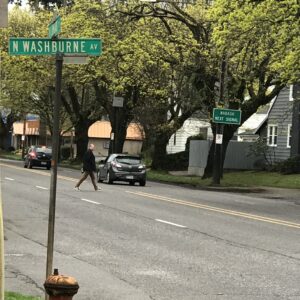“Time [the Portland Freight Committee] was sent packing or at least reconfigured”
— Lenny Anderson

(Photo © J. Maus/BikePortland)
My visit to the Portland Freight Committee (PFC) earlier this month led to an interesting revelation: Turns out, members of this influential committee think the use of large freight trucks on North Lombard should be prioritized above everything else. To say the committee is skeptical of the Oregon Department of Transportation’s plan to remove two driving lanes to make room for a bike lanes and other updates is an understatement.
Reader Lenny Anderson took notice.
Lenny knows a thing or three about how freight advocacy works in this town. Before retiring in 2013, he spent 13 years improving access to-and-from the industrial district on Swan Island (home to UPS, FedEx, and others). Known to many as “Mr. Swan Island,” one reason Lenny was so good at his job is that he understood the way to move more freight was to encourage bicycling and transit use and remove as many single-occupancy automobile users as possible. “Every two people that ride down here is a semi!” he once said.
Suffice it to say, when Lenny talks about freight, we should listen.
That’s why I think his stinging critique of the Portland Freight Committee is worth highlighting (edited slightly for readability):
“The Portland Freight Committee is a publicly funded and staffed advocacy group for more roadway capacity for motor vehicles. Make no mistake. Time it was sent packing or at least reconfigured. It has no members from affected communities like St Johns, Portsmouth or Linnton, and is dominated by corporate interests who can just call the Governor! There was a day when Portland’s economy was driven by wood chips, then micro chips (still is to some extent) but even that is not the driver it once was. (Check out economist Joe Cortright’s work on the topic.)
As for parcel delivery outfits like Fed Ex, UPS, and others who have sometimes been the most vocal on the PFC, they need to adjust their trucks to our streets, not the other way around. Go electric, buy Sprinters, use bikes with trailers to deliver your packages. And if you can’t make it work here without endangering your customers, leave the Portland market; someone more willing to adapt to the 21st century will take your place.”
Well said Lenny. Hopefully someone at PBOT Commissioner Eudaly’s office takes note.
And thanks for continuing to stay engaged with these issues. Hope you’re enjoying your retirement!
— Jonathan Maus: (503) 706-8804, @jonathan_maus on Twitter and jonathan@bikeportland.org
— Get our headlines delivered to your inbox.
— Support this independent community media outlet with a one-time contribution or monthly subscription.




Thanks for reading.
BikePortland has served this community with independent community journalism since 2005. We rely on subscriptions from readers like you to survive. Your financial support is vital in keeping this valuable resource alive and well.
Please subscribe today to strengthen and expand our work.
I agree with Lenny’s points. I’m an avid biker and just hearing about the plan to eliminate two driving lanes from Lombard. Lenny’s important points aside – why is the city planning to reduce lanes on N Lombard? This is worst idea. Even if Lombard had a bike lane I would never use it when I can use nearby streets that are residential/bikeways. Lombard NEEDS the existing lanes to manage the traffic flow. Reducing the lanes is going create a nightmare situation. Does anyone on that project drive that corridor?
Correct me if I’m wrong, but Lombard is one of two (maybe 3?) streets that connects neighborhoods around the MAX Yellow Line and St. John’s. Whereas Willamette/Rosa Parks is mostly residential and Columbia is mostly commercial; Lombard has housing, businesses, parks, schools, churches, etc. It’s a true “street” (in the classical sense of the word) so a reduction to auto capacity seems long past due in my opinion.
I’d love to see protected bike lanes and/or bus only lanes on Lombard as a way to unlock the potential the corridor has; a lively street which also serves to connect St. John’s to the rest of Portland.
Yeah, don’t agree.
Lombard is treated by drivers like a freeway, but because of no turn lanes and all the lights really fails at that and is a high crash corridor. I believe the community will be much richer when the roadway does not look like a highway, people slow down a little and the businesses nearby can hopefully thrive more. When you get past Columbia Park (heading NW) and Lombard becomes one lane with a turn lane, it really doesn’t seem much slower. Now one is advocating to add lanes there because of massive traffic backups. Right now the section being redesigned is a big divider to pedestrians and cyclists and is generally not very safe for anyone. I applaud ODOT/PBOT for trying something. Fewer accidents, safer crossing, less noise will improve the corridor for the community. Seems like a great trade off to me.
Okay, I just read the prior article about the project. I’m for the crosswalks, but super skeptical of the lane reduction. I’m not going to want to bike alongside the exhaust filled traffic nightmare from single lanes.
I hear you Ashley. But I think having legal, dedicated space for bicycling is very important on major commercial streets like Lombard. We must grab the space whenever possible and then work on the “traffic nightmare” part of the equation. When we can get freight haulers to move to Columbia and/or get people to slow way down, I think it’ll be much nicer. We also need to keep pushing for wider bike lanes that have physical protection.
Moving the needle on cycling (including e-bikes/cargo bikes/e-scooters, etc.) as a mode share means we need to dedicate (protected) space on the most direct and convenient routes throughout the entire roadway network rather than relegate the side streets and scraps to low-impact, non life-threatening modes for underserved humans. Motordom is part of a patriarchal society.
Ashley, I recommend you get on your bike and ride up Barbur (be careful on the two bridges where you lose the bike lane). Turn left at the crosswalk past McD’s and then right on Capitol Hwy. Soon you’ll see what can happen when four lanes of “neighborhood freeway” are converted to two travel lanes, one center turn lane, and protected bike lanes on each side.
You’ll want to ride your bike there!
It’s not an “exhaust-filled traffic nightmare” at all. There are two main benefits:
1) You don’t worry as much about being run down from behind b/c you’re riding in your own space, more or less.
2) The car and truck traffic is a lot calmer! This is the main difference. Before where you had cars racing to get around the slower vehicles – everyone trying to go as fast as possible – you now have cars traveling in an orderly line in each direction, well within the speed limit.
I agree with Jonathan: the calmed streets are not nirvana but they are a huge improvement for all road users – car drivers included, as they are less likely to be maimed in a high-speed collision.
I’m familiar with the route. I can’t get behind the Lombard projects in terms of bike lanes. Why would I take Lombard when I can take Rosa Parks/Willamette? We’re seeing a rise in car commuting, and a decrease in bike commuting and I see angry people in long single lane commute lines peeling off right and left to get around the traffic regardless. I just don’t think it’s the right artery for bike lanes.
I think you are thinking about this project in terms of its viability as a through street. Going East – West north of Lombard is a tedious process. You really have to know what you are doing and where you are going because the roads in north of Lombard all try and get you onto Lombard. Cyclist will bike on Lombard for the same reason cars drive on Lombard, its uncomplicated and open. If you live in Kenton and want to go to St. Johns, you shouldn’t have to go all the way to Rosa Parks/Willamette
“We’re seeing a rise in car commuting, and a decrease in bike commuting.” Sorry, but I can’t get behind that.
We need to see a decrease in car commuting and an increase in bike commuting. We’ve always made car commuting super-easy and bike commuting super-difficult. This modest project on Lombard is one small step in turning the tables.
In every lane reduction project I’ve seen, or heard from people about, where a bike lane is replacing an auto lane there are drivers using the bike lane for passing traffic. Actually a project isn’t needed, it’s common everywhere there’s a bike lane for it to be used by motor vehicle drivers to pass other traffic.
Yes yes and yes! I totally agree with Lenny, paraphrasing ‘Every two [SOVs] commuting to the port takes up a semi truck space’. But this point is often blissfully ignored locally…
There is another similar battle taking place behind closed doors in SW Washington: the Port of Vancouver is trying to ‘muscle’ WSDoT into not upgrading the Mill Plain SR501 couplet in downtown Vancouver into a safer / truck friendly Complete Street with bike lanes. [This would complete the MPX bike lanes done in 1999. And even worse than Swan Island: there is no understanding or real interest / past efforts to effectively reduce the Port’s commuter trips impact on their freight capacity by promoting alt commuter trips to the port and a real transit (CTRAN) service to the heart of the port. [The Port’s Air Quality / Commuter Program page still lists the Streets Trust as the BTA. LOL.]
PS> Thanks Lenny! (I miss working with you on this topic.)
WSDoT SR501 project currently proposes buffered bike but the Port of Vancouver is pushing them to be stripped away.
https://www.wsdot.wa.gov/Projects/SR501/i5toportofvanimprove/default.htm
Many companies that make private profits from the public right of way pay cities taxes for the privilege (gas, cable, phone, etc.). It’s about time we start taxing Amazon and the like for the full freight of the cost of their clogging up our cities. Not doing so is just subsidizing huge corporations to run local businesses out of business while running over local cyclists and pedestrians.
The thing that gets me about amazon is how bad the drivers are. I saw one with packages and a hand truck spilling out of her van a month or two ago, and then had a fun incident with another one while crossing NE Killingsworth at 37th after dark a few weeks later.
I was attempting to cross south in the cross walk and inched about 1/3 of the way out as the Amazon van approaches heading west. He slows and clearly sees me, but then he’s like, “Oh! It’s just some guy in the crosswalk!” And speeds up and swerves around me and keeps going.
My point is that Amazon drivers are NOTHING like UPS or FedEx drivers in terms of training and professionalism, and I bet pay as well.
You get what you pay for.
I see just as many UPS and FedEx trucks being used illegally as I do the nameless white Amazon delivery vans. Amazon doesn’t want feedback from their fleet of non-professional drivers, thus the plain white vans with no branding.
“Many companies that make private profits from the public right of way pay cities taxes for the privilege (gas, cable, phone, etc.).”
Those aren’t taxes, those are utilities. Completely different ball of wax.
Often, large employers will get large tax breaks (property tax, city tax, etc) from cities as an enticement to bring their company to the city. In which case, those large companies making private profits from public right of way aren’t even paying for the privilege to be able to do so!
Quote: {“As for parcel delivery outfits like Fed Ex, UPS, and others who have sometimes been the most vocal on the PFC, they need to adjust their trucks to our streets, not the other way around. Go electric, buy Sprinters, use bikes with trailers to deliver your packages. And if you can’t make it work here without endangering your customers, leave the Portland market; someone more willing to adapt to the 21st century will take your place.”}
Let’s see Lenny’s economic evaluation of the current business practices, compared to using electrics, Sprinters, and bike trailers to move the freight. Wonder why he did not provide that. I suspect the added manpower, and increased cost to deliver a package would make his proposal seem laughable even to BP readers.
One would think that in these days of people working multiple jobs, increasing opportunities for employment would be jumped at. And in this case it would be a win-win with carbon neutral transport to go with the increased employment.
You’re wondering why the cost of safety was not included in his off-hand comment? How much are you willing to pay to stay alive? Cost is not the issue. If you want numbers pull them from any European city where they’ve already been doing this for decades.
If you think the readers here are worried about the cost of their cheap junk delivered within 2 days via Amazon Prime then you don’t know this demographic.
Lenny is spot on, and it’s not just economics, esp. when externalities like safety and pollution are not borne by the trucking companies.
We should not tolerate the pollution of delivery vehicles which aren’t even legal in CA anymore so they bring them up here.
(https://www.oregonlive.com/environment/2015/01/oregon_becomes_dumping_ground.html)
And as for economics, and they still seem to be in biz in CA just fine with cleaner vehicle requirements.
UPS and FedEx are rolling coal through our neighborhoods, which is shameful.
https://www.mcgill.ca/newsroom/channels/news/air-pollution-nanoparticles-linked-brain-cancer-302590
Love this comment – thank you Lenny!
I have two serious complaints about equity and the freight committee that I submitted to the Ombudsmen. They have refused to add the I-5 Journey Time Reliability Network analysis to their agenda. This committee needs to be dismantled and regrouped at Metro. They have lost their moral compass. Sometimes if you listen to women of color they will find the cheapest solution. This committee is not interested in cheap community driven solutions they are driven by the motives of their profit driven companies. If you are pissed at the City call Tony Green the Ombudsmen and tell him to audit this committee. Cause he isn’t listening to me.
A bit off topic, but I would welcome an explanation from city staff and decision makers why the PFC member roster appears to be exempt from the term limits that were imposed on all other city advisory committees in November 2017.
Interesting that the webpage on implementation of Resolution 37328 is still “under construction”. https://www.portlandoregon.gov/civic/76172
PFC Roster: https://www.portlandoregon.gov/transportation/article/448515
Working on this.
(From what I’ve heard so far the PFC thinks they are special because they are a “technical committee” formed exclusively for the freight master plan. LOL)
I’d like it if they would pave the whole peninsula so I could just follow line of sight wherever I want to go.
THIS!
Portland’s streets are not bad as far as urban city streets go and if distributors; both residential parcel and commercial deliveries can’t navigate safely it’s really concerning. I now live in the midAtlantic where most of the infrastructure was designed in the early 1700s. Retrofitting the streets for modern amenities is… difficult. Yet those same type of drivers have to navigate even tighter spacers with more hazards and worse weather.
The vehicles are too big and definitely could benefit from smaller, localized delivery hubs – as mentioned previously; sprinter vans or cargo bikes etc to mitigate these issues.
But we need to get serious about infrastructure and stop saying it’s “good enough.”
Maybe there should be roads dedicated to freight? Maybe there should be roads dedicated to passenger vehicles? In exchange, both freight and passenger vehicle access could be drastically reduced. Walls could be built around the roads to keep in the noise, and multi use bridges could be built over them. This way there would be no crossing the streams. Complete fantasy, but it’s far better in my mind than what we have or where the road goons are going.